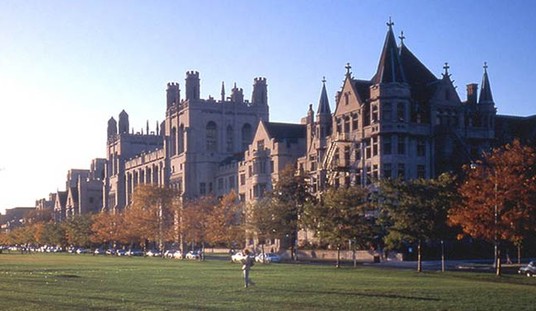The weekend produced a spate of dang-this-is-bad articles on the economic situation in California. Steven Greenhut’s for the Orange County Register is entitled “California to middle class: drop dead.” At The Daily Beast, Joel Kotkin laments that “As California Collapses, Obama Follows its Lead.” (H/t – and a “Read it, people!” shout-out – to Ed Driscoll at PJM.)
But what does all this look like in terms of numbers? What’s the how much and where and whom of the Golden State collapse? Perhaps the most interesting and telling thing is that it really is as bad as it looks. And the reasons are pretty much what you’d expect. Here’s the California story, in numbers.
According to a March 2012 report, 855,000 is how many private-sector jobs California has lost since the recession started four years ago. (H/t: California Political News & Views.) The state today enjoys an unemployment rate of 11%, compared with the official national average of 8.3%
Texas, by contrast, has added 139,800 jobs, posting the biggest absolute gain among the 50 states. (California’s is the biggest absolute loss.) Texas’ unemployment rate is 7.1%. Number 3 on the job-growth list? The District of Columbia, with 21,000 added private-sector jobs. Government is big business.
But we were talking about California. How does California rank in terms of the average state and local tax burden? According to the Tax Foundation, in 2009, California had the 6th heaviest tax burden in the nation, at 10.6%. (New Jersey was #1, followed by New York at #2.) That’s the in-state tax burden, of course. Federal taxes are on top of that.
Of course, business climate comprises more than the average individual tax burden. The Tax Foundation looks at five forms of taxation – corporate tax, individual income tax, sales tax, property tax, and unemployment insurance tax – to index the business climates of the 50 states. By this combined measure, the Tax Foundation ranks California 48th in business climate. (New York is 49th, and New Jersey 50th.)
State regulatory environment? George Mason University’s Mercatus Center ranks the Golden State 48th in the nation. New Jersey and New York are numbers 49 and 50, respectively.
How about other business costs? California had the 5th highest state premium ranking for worker compensation insurance costs in 2010 (although the state’s position improved slightly in 2011 due to other states raising their state premiums).
California ranks 7th highest in electric utility costs, with Hawaii being the highest, followed by Connecticut and Alaska.
According to the Small Business & Entrepreneurship Council, California has the third-highest per-gallon gasoline tax (Connecticut and New York are #1 and #2) and by far the highest tax on diesel, at 52.5 cents per gallon. (Some numbers below also come from the SB&EC report.)
California perennially has the second-highest gasoline prices at the pump (Hawaii is #1), although the state has regularly been ranked 3rd or 4th in oil production in recent years. (In the past week the statewide average was $4.15 for a gallon of regular, down from $4.36 a month ago.) In spite of having the third largest oil and gas reserves of any state in the nation, California is ranked dead last among all US jurisdictions for global oil investment. The fact that California hasn’t issued a new offshore drilling permit for over 30 years is undoubtedly a factor, as is the fact that the Monterey Shale Oil Field, which holds 64% of all the recoverable shale oil in the United States, is hamstrung by lawsuits, a typical condition in the state for both drilling and refining operations.
In spite of the state’s natural bounty, California produces only 37% of its statewide oil consumption. The rest comes from other states and countries, at added expense.
In terms of the employer burden of health-insurance mandates, California is 9th among the 50 states and the District of Columbia. (Rhode Island, Maryland, and Minnesota have the highest burdens.)
Meanwhile, California ranks 4th highest in state and local government spending per capita. The District of Columbia is the highest, followed by Alaska, Wyoming, and New York.
Ah, yes, state spending. California has by far the largest debt of any US state, at around $612 billion with state and local debt and pension liabilities included. In terms of raw numbers, New York posts a pathetic second place with only $305 billion. The size of California’s population allows the Golden State to slip to only 7th place in terms of per capita state and local debt. The District of Columbia walks off with another prize in this category, having on the books 85% more debt per capita than the 50-state average.
The California debt spiral is due in part to the steep decline in state tax revenues. The 22% year-on-year decline observed in February 2012 doesn’t tell the whole story either; California had already posted dramatic revenue losses in business and property taxes between 2007 and 2010. Business-tax revenues dropped 18% in that period, and property-tax revenues fell 30% due to the real estate market crash.
Let’s talk population trends. Many readers are familiar with the arresting Golden State statistics cited by a Wall Street Journal article in March:
From the mid-1980s to 2005, California’s population grew by 10 million, while Medicaid recipients soared by seven million; tax filers paying income taxes rose by just 150,000; and the prison population swelled by 115,000.
The net gain in tax filers includes the author: I was added as a tax-paying filer to the California income tax rolls in 2004. Apparently there are another 149,999 of us, and I’m thinking we need a T-shirt. (And yes, alert readers, I understand that this was a net gain, reflecting both additions to and subtractions from the tax rolls over time. Just having some fun with these sad little numbers.)
California also has the distinction of having 12% of the US population and 33% of the nation’s welfare recipients. Governor Jerry’s Brown’s 2012-13 budget proposal includes $100 billion for health and human services, which, on an annualized basis, is more than all the state and local spending in 27 of the 50 states.
In California, meanwhile, the tax code is steeply progressive. Prior to the recession, the state got 45% of its income tax revenues from the top 1% of filers. As the Wall Street Journal pointed out last year, the incomes of filers in that top 1% — which in California starts at $490,000 – are more volatile than the incomes of other filers. California, New York, Connecticut, and Illinois are some of the states most dependent for revenue on the top 1%, and they have opened up the biggest state deficits during the recession.
How many businesses are leaving California? In 2011, 254 businesses left California, or an average of 5 per week. 202 left in 2010, 51 in 2009. Even “green” businesses are leaving California. The business environment is that overregulated, and costs are that high. A business saves, on average, between 20% and 40% on costs by moving out of California. (Even the lower figure is astounding for a move within the same nation.)
But according to a 2011 report, 2500 employers ceased operations in California between 2007 and 2011. The great majority of them simply went out of business. (I can certainly vouch for the observability of that trend in my area of Southern California. Besides small businesses closing – I can’t seem to keep a dry cleaner for longer than 6 months – we’ve had a number of big chain businesses pull out, leaving gigantic empty stores and parking lots. The last time I stocked up on household supplies at the local Wal-Mart, there were no greeters at the doors. An ominous portent.) How did California’s real GDP growth rank in 2011? 34th in the United States.
As of January 2012, which state had the highest average mortgage debt per household? California, with $313,000. California has had the second highest foreclosure rate of any state throughout the recession (Nevada has the highest). In terms of the state’s percentage of underwater mortgages, California ranks only 6th (Nevada, again, is #1). But that’s a little deceiving, since the value of the underwater mortgages in California is over $544 billion. That sum represents nearly 30% of total mortgage debt in California, which is $1.94 trillion – or 22% of all mortgage debt in the United States.
Well, but which state had the highest tuition hike for its state university system in 2011? That would be California, with a tuition jump of 21%. (This hike mitigated somewhat the advantage of in-state tuition for those here illegally, which California offers along with 11 other states.)
Oh, and California has far and away the most endangered animal species, with 111. No other state comes close. Hawaii has California beat on endangered plant species, however, with 273 to the Golden State’s 178.
J.E. Dyer’s articles have appeared at The Green Room, Commentary’s “contentions,” Patheos, The Weekly Standard online, and her own blog, The Optimistic Conservative.
This post was promoted from GreenRoom to HotAir.com.
To see the comments on the original post, look here.







Join the conversation as a VIP Member